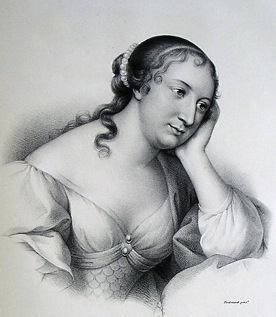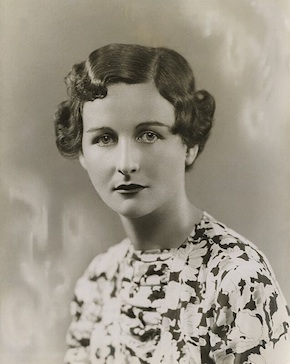The speculative birth of a princess
by Nancy Mitford
“I do love translating, it is the pure pleasure of writing without the misery of inventing.” Nancy Mitford
The Princesse de Clèves, a historical novel about the Court of Henri II, seems to have been conceived early in the year 1671. Many French critics think that, on the evidence of her letters to the Abbé Ménage and of her earlier novels, the Princesse de Montpensier and Zayde, Madame de Lafayette must have had a great deal of help with the Princesse de Clèves: some have definitely stated that it was by the Duc de La Rochefoucauld and others have attributed it to M. de Segrais. But it must be said in defence of Madame de Lafayette that it is by no means unheard-of for an author to write a lot of indifferent books and a single masterpiece. All writing depends for its merit upon the imaginative spark and upon the interest felt by the author in his subject; this spark and this interest could easily have been lit by such a character as the Duc de Nemours or such a circumstance as Madame de Clèves’s confession, and might not have happened to be so lit again. However, speculation is useless and we shall never really know whether Madame de Lafayette wrote the Princesse de Clèves alone, or, if in collaboration, how much was her own. What we do know is that the little group of friends helped her enormously with the historical details, that they all settled down together to a minute study of Brantôme and the other historians and memorialists of Henri II and his times, and that the novel was read and criticized and discussed, at every stage of its creation, in the Chambre du Sublime1.
Hardly was the Princesse de Clèves begun than its progress was retarded by a terrible tragedy which befell M. de La Rochefoucauld. On one day, 17 June 1671, in the war against Holland, his eldest son, the Prince de Marsillac, was gravely wounded, his second son, the Chevalier de Marsillac, was killed, and so was his adored illegitimate son, the Duc de Longueville, the idol of his old age. He was utterly broken by the death of M. de Longueville and could hardly even make the effort of pretending that his grief was on account of the Chevalier. His friends gave themselves up to trying to console him, they surrounded him with love and attentions; a great deal of ingenuity had to be expended in keeping away les pleureuses, fashionable women like Mesdames de Brissac and Marans who, each pretending to have been the beloved of M. de Longueville, would come and upset the poor Duke with their wailing. Not until December did he renew his interest in life; then, by degrees his friends coaxed him to begin on a new set of Maxims and he soon turned his attention once more to the historical background for the Princesse de Clèves.
At last the Princess was ready for her début, a ceremony that was prepared for months beforehand with the greatest care and attention to detail by Madame de Lafayette’s little band of faithful admirers.”
Another interruption occurred in February 1673, when M. de Lafayette paid one of his rare visits to his family and bored them all with descriptions of beautiful nature in Auvergne. He seems to have enjoyed himself, and stayed on and on until at last the grape harvest made it necessary for him to go back. Hardly had he taken himself off than Madame de Sévigné returned to Paris after a long visit to Provence; she had to be welcomed, consoled for the parting with her daughter, and told all the news. Then the Chevalier de Sévigné, Madame de Lafayette’s stepfather, died, leaving a tiresome will to be contested – another lawsuit – then Segrais, that mine of historical information, decided to marry (most unnecessary of him), and as if that was not bad enough, to go and live at Caen. Finally, and by far the most tedious of all, a thin sunburnt man appeared at the rue de Vaugirard announcing himself as M. de Lafayette’s long-lost sailor brother, and proceeded to hold forth unceasingly about naval warfare and his two captured English frigates. Every writer experiences this sort of interruption and knows too well how upsetting they are to the quiet and even flow of thought without which creative work can hardly be achieved. To make things worse, Madame de Lafayette was now having liver trouble and M. de La Rochefoucauld’s gout was so bad that he often screamed aloud with pain; the only remedy that did him any good at all was viper soup, and the poor man longed for death.
At last, however, in 1677, the Princess was ready for her début, a ceremony that was prepared for months beforehand with the greatest care and attention to detail by Madame de Lafayette’s little band of faithful admirers. Readings of the book were given to ‘des personnes très éclairées’ who then did their bit by praising it to the skies wherever they went. Soon it was the talk of the town; and everybody knew that it was by Madame de Lafayette, in spite of her strenuous disclaimers.
1 The coterie of influential literary figures who gathered at Madame de Lafayette’s home on rue de Vaugirard became known as the ‘cabale du sublime’.
from the introduction to The Princesse de Clèves (rivverrun editions, £8.99)
 Madame de Lafayette was born in Paris in 1634. After living in the country with her husband for a time, she returned to Paris in the 1660s. There, she ran a literary salon from her home and cultivated connections with the court of King Louis XIV. La Princesse de Clèves was published anonymously in 1678, became an immediate succès de scandal and is considered a classic of French literature.
Madame de Lafayette was born in Paris in 1634. After living in the country with her husband for a time, she returned to Paris in the 1660s. There, she ran a literary salon from her home and cultivated connections with the court of King Louis XIV. La Princesse de Clèves was published anonymously in 1678, became an immediate succès de scandal and is considered a classic of French literature.
Marie Madeleine Pioche de La Vergne, comtesse de Lafayette, c. 1678.
Artist unknown. Wikimedia Commons
 Nancy Mitford was an English novelist, biographer and journalist who wrote classics such as The Pursuit of Love and Love in a Cold Climate. She was celebrated for her wit, social insight and satire. The Princesse de Clèves by Madame de Lafayette, translated and introduced by Nancy Mitford, was first published by Euphorion Books in 1950 and is now released in a new edition with a preface by Selina Hastings by riverrun Editions, a new paperback list dedicated publishing translations of classic texts to be enjoyed by a new generation of readers.
Nancy Mitford was an English novelist, biographer and journalist who wrote classics such as The Pursuit of Love and Love in a Cold Climate. She was celebrated for her wit, social insight and satire. The Princesse de Clèves by Madame de Lafayette, translated and introduced by Nancy Mitford, was first published by Euphorion Books in 1950 and is now released in a new edition with a preface by Selina Hastings by riverrun Editions, a new paperback list dedicated publishing translations of classic texts to be enjoyed by a new generation of readers.
Read more
Portrait of Nancy Mitford by Bassano Ltd, 1932. National Portrait Gallery/Wikimedia Commons

